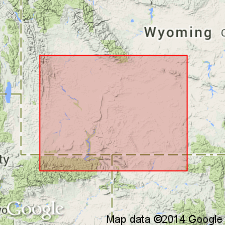
- Usage in publication:
-
- Nightingale Member
- Modifications:
-
- Named
- Dominant lithology:
-
- Shale
- Sandstone
- AAPG geologic province:
-
- Green River basin
Summary:
Named as lowermost member of Wasatch Formation. Type section designated in N1/2 sec 17, NE1/4 sec 18, and SE1/4 sec 7, T18N, R105W, two mi northeast of Nightingale Compressor Station on Mountain Fuel Supply Company Natural Gas Pipeline, for which unit is probably named, Sweetwater Co, WY, Greater Green River basin. Occurs in western part of T18N, R105W. In subsurface consists of grayish blue-green shales interbedded with light-gray, fine-grained, micaceous sandstones. Deposited in non-red bed fluviatile environment. At type, unit includes only main body of Wasatch that underlies Luman Tongue of Green River; a few mi to north Luman is missing and Nightingale includes most of equivalents of Niland Tongue of Wasatch. By definition, Nightingale does not include thick lacustrine, red bed or coal-bearing rocks; in this respect it differs from Red Desert Member of Wasatch. Differs from Hiawatha Member [Wasatch] (a name which author says should be abandoned) in that it does not include Luman and Niland Tongues, Ramsey Ranch Member (new) of Green River Formation or Paleocene rocks. Most of main body of Wasatch surrounding Rock Springs uplift can be included in Nightingale. Thickness at type is 1230 ft. Overlies Fort Union Formation; underlies Ramsey Ranch. Chart showing previous nomenclature; restored section. Age not specified; presumably Eocene age.
Source: GNU records (USGS DDS-6; Denver GNULEX).
For more information, please contact Nancy Stamm, Geologic Names Committee Secretary.
Asterisk (*) indicates published by U.S. Geological Survey authors.
"No current usage" (†) implies that a name has been abandoned or has fallen into disuse. Former usage and, if known, replacement name given in parentheses ( ).
Slash (/) indicates name conflicts with nomenclatural guidelines (CSN, 1933; ACSN, 1961, 1970; NACSN, 1983, 2005, 2021). May be explained within brackets ([ ]).

